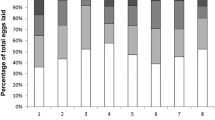Summary
We examined the relationship between queen number and worker size in colonies of the fire antSolenopsis invicta. Worker size in monogyne colonies was significantly greater than in polygyne colonies; furthermore, polygyne colonies snowed a strong negative linear relationship between queen number and worker size. Higher queen pheromone level and/or decreased food availability accompanying an increase in queen number likely play important roles in producing the observed patterns.
Similar content being viewed by others
References
Elmes, G. W., 1974. The effect of colony population on caste size in three species ofMyrmica (Hymenoptera Formicidae).Ins. Soc. 21:213–230.
Greenberg, L., D. J. C. Fletcher and S. B. Vinson, 1985. Differences in worker size and mound distribution in monogynous and polygynous colonies of the fire antSolenopsis invicta Buren.J. Kans. Entomol. Soc. 58:9–18.
Holldobleri, B. and E. O. Wilson, 1990.The Ants. The Belknap Press of Harvard University Press, Cambridge, Mass.
Jouvenaz, D. P., G. E. Alien, W. A. Banks and D. P. Wojcik, 1977. A survey for pathogens of fire ants.Solenopsis spp., in the southeastern United States.Fla. Entomol. 60:275–279.
Pisarski, B., 1981. Intraspecific variations in ants of the genusFormica L. In:Biosystematics of social insects, (P. E. Howse and J. -L. Clement, Eds.), Academic press, London and New York. pp. 17–26.
Porter, S. D., A. Bhatkar, R. Mulder, S. B. Vinson and D. J. Clari, 1991. Distribution and density of polygyne fire ants (Hymenoptera: Formicidae) in Texas.J. Econ. Entomol. 84:866–874.
Porter, S. D. and W. R. Tschinkel, 1985a. Fire ant polymorphism (Hymenoptera: Formicidae): factors affecting worker size.Ann. Entomol. Soc. Am. 78:381–386.
Porter, S. D. and W. R. Tschinkel, 1985b. Fire ant polymorphism: the ergonomics of brood production.Behav. Ecol. Sociobiol. 16:323–336.
Ross, K. G., 1993. The breeding system of the fire antSolenopsis invicta: effects on colony genetic structure.Am. Nat. 141:554–576.
Shoemaker, D. D., J. T. Costa III and K. G. Ross, 1992. Estimates of heterozygosity in two social insects using a large number of electrophoretic markers.Heredity 69:573–582.
Vargo, E. L. and D. J. C. Fletcher, 1986. Queen number and the production of sexuals in the fire ant,Solenopsis invicta (Hymenoptera: Formicidae).Behav. Ecol. Sociobiol. 19:41–47.
Vargo, E. L. and D. J. C. Fletcher, 1989. On the relationship between queen number and fecundity in polygyne colonies of the fire antSolenopsis invicta.Physiol. Entomol. 14:223–232.
Vargo, E. L. and S. D. Porter, 1989. Colony reproduction by budding in the polygyne form ofSolenopsis invicta (Hymenoptera: Formicidae).Ann. Entomol. Soc. Am. 82:307–313.
Author information
Authors and Affiliations
Corresponding author
Rights and permissions
About this article
Cite this article
Goodisman, M.A.D., Ross, K.G. Relationship of queen number and worker size in polygyne colonies of the fire antSolenopsis invicta . Ins. Soc 43, 303–307 (1996). https://doi.org/10.1007/BF01242931
Revised:
Accepted:
Issue Date:
DOI: https://doi.org/10.1007/BF01242931




